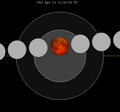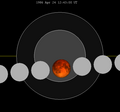April 1986 lunar eclipse
| Total Lunar Eclipse April 24, 1986 | |
|---|---|
| (No photo) | |
 The moon passes west to east (right to left) across the Earth's umbral shadow, shown in hourly intervals. | |
| Series | 131 (32 of 72) |
| Duration (hr:mn:sc) | |
| Totality | |
| Partial | |
| Penumbral | |
| Contacts | |
| P1 | UTC |
| U1 | |
| U2 | |
| Greatest | |
| U3 | |
| U4 | |
| P4 | |
A total lunar eclipse took place on Thursday, April 24, 1986, the first of two total lunar eclipses in 1986, the second being on October 17, 1986.
Visibility
It is seen rising over eastern Asia, the Pacific Ocean, and western North America and South America, the eclipse is also seen setting over the whole of Europe, Africa and Western Asia. The eclipse was seen very visible over the Philippines, it becomes the first lunar eclipse after the EDSA Revolution since the two lunar eclipses happened between May 4, 1985 and October 28, 1985 and the second followed on October 17, 1986. It also followed on February 20, 1989.
Eclipses in 1986 are:
Partial Solar eclipse of April 9, 1986
Total Lunar Eclipse of April 24, 1986
Hybrid Solar eclipse of October 3, 1986
Total Lunar Eclipse of October 17, 1986 (October 1986 lunar eclipse)
It also followed the passage of Halley's comet in the same year.
Related lunar eclipses
Eclipses of 1986
- A partial solar eclipse on April 9.
- A total lunar eclipse on April 24.
- A hybrid solar eclipse on October 3.
- A total lunar eclipse on October 17.
Lunar year series
| Lunar eclipse series sets from 1984–1987 | ||||||||
|---|---|---|---|---|---|---|---|---|
| Descending node | Ascending node | |||||||
| Saros | Date Viewing |
Type Chart |
Gamma | Saros | Date Viewing |
Type Chart |
Gamma | |
| 111 | 1984 May 15
|
Penumbral
|
1.11308 | 116 | 1984 Nov 08
|
Penumbral
|
−1.08998 | |
| 121 | 1985 May 04
|
Total
|
0.35197 | 126 | 1985 Oct 28
|
Total
|
−0.40218 | |
| 131 | 1986 Apr 24
|
Total
|
−0.36826 | 136 | 1986 Oct 17
|
Total
|
0.31887 | |
| 141 | 1987 Apr 14
|
Penumbral
|
−1.13641 | 146 | 1987 Oct 07
|
Penumbral
|
1.01890 | |
| Last set | 1984 Jun 13 | Last set | 1983 Dec 20 | |||||
| Next set | 1988 Mar 03 | Next set | 1988 Aug 27 | |||||
Saros series
Lunar Saros series 131, has 72 lunar eclipses. Solar Saros 138 interleaves with this lunar saros with an event occurring every 9 years 5 days alternating between each saros series.
This eclipse series began in AD 1427 with a partial eclipse at the southern edge of the Earth's shadow when the Moon was close to its descending node. Each successive Saros cycle, the Moon's orbital path is shifted northward with respect to the Earth's shadow, with the first total eclipse occurring in 1950. For the following 252 years, total eclipses occur, with the central eclipse being predicted to occur in 2078. The first partial eclipse after this is predicted to occur in the year 2220, and the final partial eclipse of the series will occur in 2707. The total lifetime of the lunar Saros series 131 is 1280 years. Solar Saros 138 interleaves with this lunar saros with an event occurring every 9 years 5 days alternating between each saros series.
Because of the ⅓ fraction of days in a Saros cycle, the visibility of each eclipse will differ for an observer at a given fixed locale. For the lunar Saros series 131, the first total eclipse of 1950 had its best visibility for viewers in Eastern Europe and the Middle East because mid-eclipse was at 20:44 UT. The following eclipse in the series occurred approximately 8 hours later in the day with mid-eclipse at 4:47 UT, and was best seen from North America and South America. The third total eclipse occurred approximately 8 hours later in the day than the second eclipse with mid-eclipse at 12:43 UT, and had its best visibility for viewers in the Western Pacific, East Asia, Australia and New Zealand. This cycle of visibility repeats from the initiation to termination of the series, with minor variations. Solar Saros 138 interleaves with this lunar saros with an event occurring every 9 years 5 days alternating between each saros series.
Lunar Saros series 131, repeating every 18 years and 11 days, has a total of 72 lunar eclipse events including 57 umbral lunar eclipses (42 partial lunar eclipses and 15 total lunar eclipses). Solar Saros 138 interleaves with this lunar saros with an event occurring every 9 years 5 days alternating between each saros series.
| Greatest | First | |||
|---|---|---|---|---|
 The greatest eclipse of the series will occur on 2094 Jun 28, lasting 102 minutes.[1] |
Penumbral | Partial | Total | Central |
| 1427 May 10 | 1553 July 25 | 1950 Apr 2 | 2022 May 16 | |
| Last | ||||
| Central | Total | Partial | Penumbral | |
| 2148 Jul 31 | 2202 Sep 3 | 2563 Apr 9 | 2707 Jul 7 | |
| 1914 Mar 12 | 1932 Mar 22 | 1950 Apr 2 | |||

|

|

|

|

|

|
| 1968 Apr 13 | 1986 Apr 24 | 2004 May 4 | |||

|

|

|

|

|

|
| 2022 May 16 | 2040 May 26 | 2058 Jun 6 | |||

|

|

|

|

|

|
| 2076 Jun 17 | 2094 Jun 28 | ||||

|

|

|

| ||
It is the third total lunar eclipse of the series. The next occurrence will be on May 4, 2004. The previous occurrence was April 13, 1968.
Metonic series
This eclipse is the third of four Metonic cycle lunar eclipses on the same date, April 23–24, each separated by 19 years:
The Metonic cycle repeats nearly exactly every 19 years and represents a Saros cycle plus one lunar year. Because it occurs on the same calendar date, the Earth's shadow will in nearly the same location relative to the background stars.
| Descending node | Ascending node | |||||
|---|---|---|---|---|---|---|
| Saros | Date | Type | Saros | Date | Type | |
| 111 | 1948 Apr 23 | Partial | 116 | 1948 Oct 18 | Penumbral | |

|

| |||||
| 121 | 1967 Apr 24 | Total | 126 | 1967 Oct 18 | Total | |

|

| |||||
| 131 | 1986 Apr 24 | Total | 136 | 1986 Oct 17 | Total | |

|

| |||||
| 141 | 2005 Apr 24 | Penumbral | 146 | 2005 Oct 17 | Partial | |

|

| |||||
Half-Saros cycle
A lunar eclipse will be preceded and followed by solar eclipses by 9 years and 5.5 days (a half saros).[2] This lunar eclipse is related to two annular solar eclipses of Solar Saros 138.
| April 18, 1977 | April 29, 1995 |
|---|---|

|

|
See also
Notes
- ^ Listing of Eclipses of cycle 131
- ^ Mathematical Astronomy Morsels, Jean Meeus, p.110, Chapter 18, The half-saros
External links
- 1986 Apr 24 chart Eclipse Predictions by Fred Espenak, NASA/GSFC




